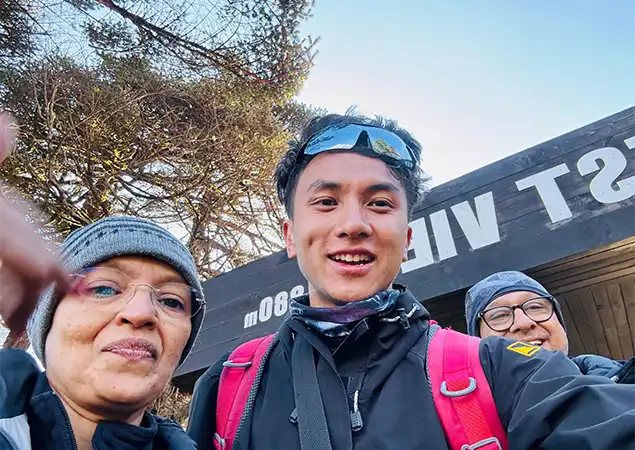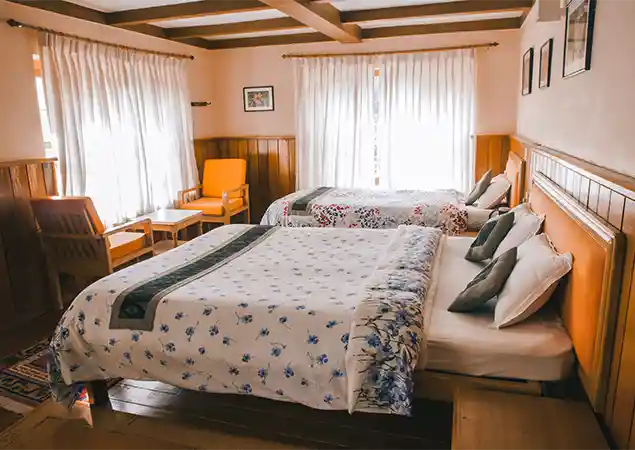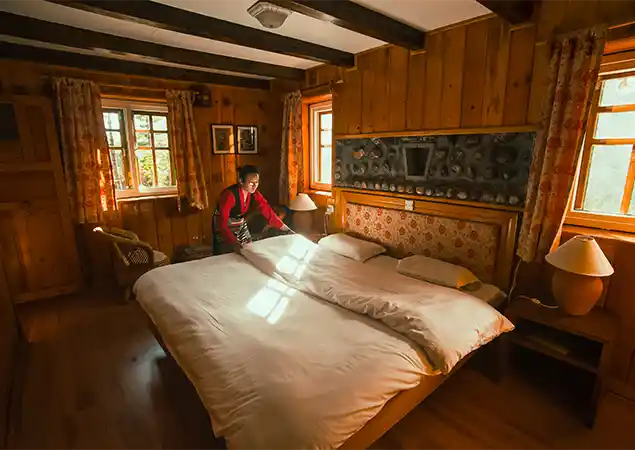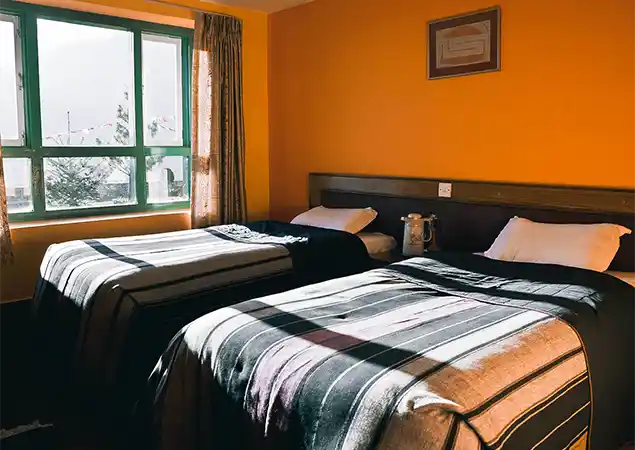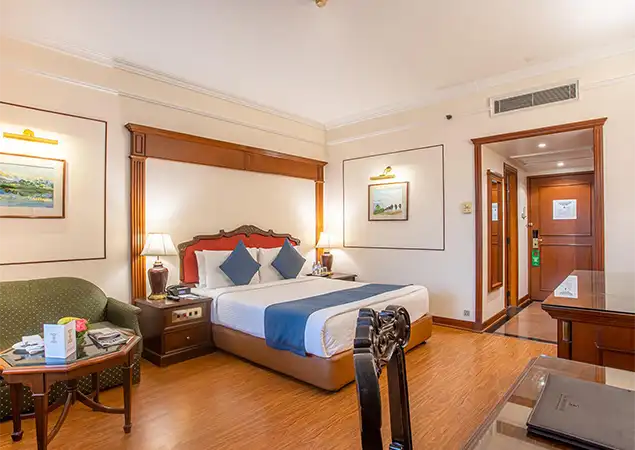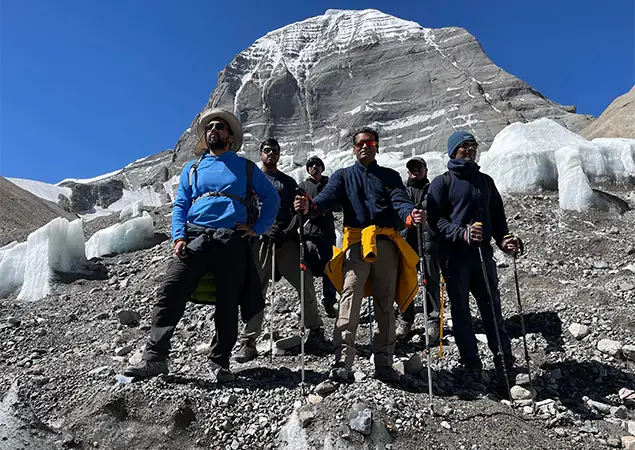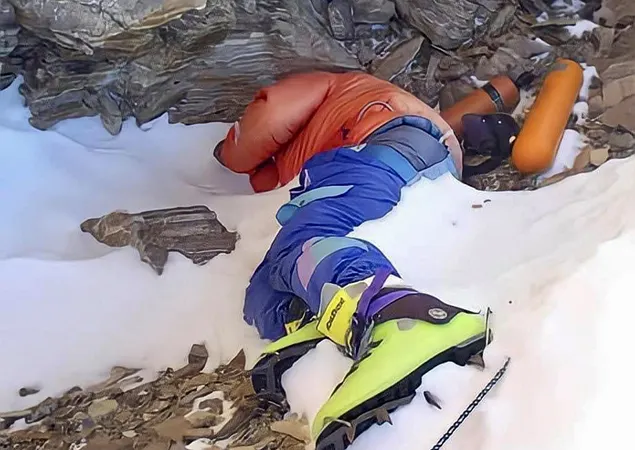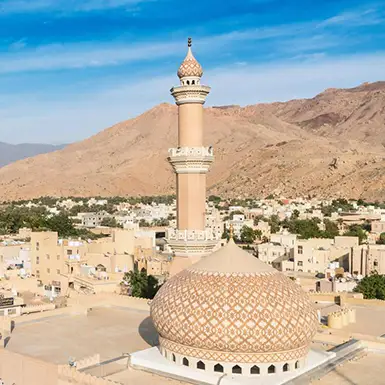Author: Admin
Accommodation: Yeti Mountain Home Namche
Accommodation: Yeti Mountain Home Phakding
Accommodation: Yeti Mountain Home Lukla
Accommodation: The Everest Hotel
Kailash Mansarovar Yatra from Australia: A Spiritual Adventure
Health and Safety Considerations
Vaccinations
It is important to consult a doctor from Australia before the Kailash Mansarovar Yatra. No specific vaccinations are mandatory, but a medical professional can provide personalized advice. Staying current with routine vaccinations promotes overall health during your pilgrimage.
Travel Insurance
Obtaining comprehensive travel insurance is essential. Ensure the policy covers high-altitude trekking and emergency evacuation. This coverage protects you financially and medically during the Kailash Mansarovar Yatra from Australia, offering peace of mind throughout the trip.
Emergency Services
Medical facilities are available in Lhasa, Shigatse, Saga, and Darchen. In case of an emergency, you can access hospitals in these cities. If you feel unwell during the Kora, an electric van can arrange immediate transportation back to Darchen. Knowing that help is readily available enhances safety during the Kailash Mansarovar Yatra from Australia.
Proper attention to health and safety ensures a secure and fulfilling experience. By taking these precautions, you can focus on your pilgrimage’s spiritual and cultural significance.
Cultural Etiquette and Responsible Tourism
Local Customs
Respecting local customs enhances the experience of the Kailash Mansarovar Yatra from Australia. Dress modestly by wearing clothing that covers shoulders and knees. Remove shoes before entering temples or monasteries. Always walk clockwise around sacred sites, following traditional practices. Asking permission before photographing people or religious artifacts shows courtesy and respect.
Environmental Responsibility
Protecting the pristine environment from Australia during the Kailash Mansarovar Yatra is vital. Use reusable water bottles with filters to minimize plastic waste. Dispose of litter properly and avoid leaving trash behind. Stick to established paths to minimize impact on delicate ecosystems. Use biodegradable soaps to prevent pollution of water sources.
Community Interaction
Positive engagement with local communities enriches the pilgrimage. Learn basic phrases in the local language to communicate politely. Help local communities by buying goods or services from local businesses. Show appreciation for their hospitality and refrain from disruptive behavior. Sharing stories and experiences fosters mutual understanding and respect.
Honoring cultural etiquette and practicing responsible tourism ensures a meaningful and respectful Kailash Mansarovar Yatra from Australia. By embracing these principles, travelers contribute positively to the communities and environments they visit.
Financial Planning
Budgeting
Planning for the Kailash Mansarovar Yatra from Australia requires careful budgeting. Flights from Australia to Kathmandu or Lhasa typically cost AUD 1,200 and AUD 2,000, depending on the season and airline. Tour packages range from AUD 5,000 to AUD 7,000, usually including accommodation, meals, guides, and necessary permits. Visa fees for China and Nepal add approximately AUD 200 to the expenses. Personal costs like travel insurance, trekking gear, and souvenirs should also be considered. Allocating a contingency fund for unexpected costs ensures financial preparedness.
Currency
Understanding currency exchange is vital for the Kailash Mansarovar Yatra from Australia. The Chinese Yuan (CNY) is the accepted currency in Tibet. Exchanging Australian Dollars to Chinese Yuan before departure or upon arrival in major cities like Lhasa is advisable. ATMs are available in Lhasa and Shigatse but may not accept all international cards. Carrying sufficient cash is important, especially when traveling to remote areas with scarce banking facilities. Keeping small denominations helps with everyday transactions.
Tipping
Tipping customs in Tibet involves showing appreciation to guides and staff. A general guideline is to tip around AUD 10 per day for guides and AUD 5 per day for drivers. Adjusting the amount based on service quality is acceptable. Presenting the tip in an envelope at the end of the trip is considered polite. Discussing tipping practices with the tour operator provides additional clarity.
Careful financial planning ensures a smooth Kailash Mansarovar Yatra from Australia. By budgeting wisely, managing currency needs, and understanding local customs, travelers can focus on the spiritual significance of their pilgrimage.
Legal and Political Considerations
Travel Advisories
Check the latest government travel advisories before planning the Kailash Mansarovar Yatra from Australia. Authorities prohibit carrying books, journals, newspapers, Tibetan flags, or any materials related to the Dalai Lama. Before entering Tibet, delete any social media posts about the Dalai Lama or Tibetan political leaders. Chinese immigration officers may deport or detain travelers with such items or content.
Political Sensitivities
Understanding the political context is crucial for a respectful pilgrimage. Refrain from discussing Tibet’s political status, and always comply with local laws and regulations during the Kailash Mansarovar Yatra from Australia. Respecting these sensitivities ensures a smooth experience and avoids legal complications.
Conclusion
Undertaking the Kailash Mansarovar Yatra from Australia can profoundly enrich your life, nurturing the soul and expanding the mind. Standing before the majestic Mount Kailash and the serene Lake Mansarovar inspires deep reflection and awe. This pilgrimage provides a rare opportunity to escape from daily routines and engage with ancient spiritual traditions. Facing and overcoming the challenges along the route fosters personal growth, resilience, and a deeper self-understanding.
Start planning your Kailash Mansarovar Yatra from Australia today. Research travel options, consult reputable tour operators, and prepare yourself physically and mentally for this sacred trek. Taking proactive steps now brings you closer to experiencing the profound impact this pilgrimage can have on your life. The path to spiritual enrichment and personal transformation awaits; seize the moment and begin your preparations.
Everest’s Silent Sentinel: The Enduring Story of Green Boots
Mount Everest rises as the highest point on Earth and draws climbers worldwide. The mountain also holds harsh markers of risk. Among them sits Everest Green Boots, one of the most well-known and haunting sights on the northeast ridge route. A climber in neon green Koflach boots lies in a small rock cave near 8,500 m, where oxygen drops fast and cold bites hard in the Everest Death Zone. Teams have passed the spot for over two decades and mark progress by it.
Many climbers stop for a moment at the cave. They check masks, fuel, and strength. The image of Green Boots Everest pushes each person to think about the thin line between summit and loss. The body acts as a silent sentinel warning about exposure, exhaustion, and limited rescue on the mountain.
Climbing culture often turns private loss into a shared story. Bright boots make the fallen climber easy to see from the fixed line. Visibility turns tragedy into a symbol. Green Boots Mount Everest now stands for human drive, human fragility, and the raw force of altitude and weather. Over time, the name grows while the person behind it fades. The landmark is an emotional and ethical touchstone for climbers facing the same slopes.
Questions follow every sighting. Should teams move past? Try to recover the remains? Save energy for living climbers in distress? Debate continues in base camps, alpine clubs, and online forums. Everest Green Boots keeps the talk active and raises awareness of risks.
The guide you read here aims to share the known story of the climber linked to the boots, outline the expedition events, explain ongoing uncertainty about identity, and explore the moral debate surrounding high-altitude bodies. Climbers who plan an Everest Expedition gain real value when they study these lessons, set clear turn-back times, and climb with respect for all who came before.
Tsewang Paljor: The Climber Many Link to Everest Green Boots
Many climbers link Everest Green Boots to an Indian mountaineer named Tsewang Paljor, a Head Constable with the Indo-Tibetan Border Police (ITBP). Bright green Koflach boots seen in the high rock alcove on the Everest northeast ridge give the landmark its name. The image of Green Boots Everest stays in the minds of summit teams who pass the spot in the thin air of the Everest Death Zone.
Early Life in Ladakh
The family home sits in Sakti village in the Leh district of Ladakh, India. Birth date: April 10, 1968. High desert valleys, cold winters, and steep peaks shape daily life in the region. Kids walk long distances, carry water, and learn respect for altitude. Paljor grew up with mountain views that sparked a drive to climb.
Service with the Indo-Tibetan Border Police
Indo-Tibetan Border Police patrols remote, high-altitude frontiers. Training includes ice travel, cold-weather survival, rope work, and load carries in thin air. Service as a Head Constable builds strength, discipline, and mental focus. Exposure to glacier travel and fixed-line movement lays the groundwork for attempts on peaks such as the Mount Everest Green Boots route on the Tibet side.
Drive to Support Family
Paljor climbs with a clear goal: to support loved ones. Success on major peaks can raise profile, open promotion paths, and bring honor back home. Family stories say his mother, Tashi Angmo, fears heavy risk and urges caution. Personal duty and ambition push him toward the Everest Expedition with the ITBP team.
What the Green Boots Story Teaches Climbers
Green Boots Mount Everest turns one climber’s loss into a standing warning for all who ascend above 8,000 m. Use the landmark as a cue to run complete system checks.
Action Checks Near Green Boots Cave
- Confirm oxygen flow, spare bottle pressure, and mask fit.
- Check the regulator heat tape and hose ice.
- Eat a quick gel or chew for calories; sip from an insulated bottle.
- Review turnaround time with the team lead; stick to the plan.
- Watch partners for frostbite signs, slurred speech, or slow clip-ins.
- Log the location on the radio, so support teams can track the climber’s progress.
Risk Planning Before Summit Push
- Build extra acclimatization nights at Camp 3 or higher.
- Stage one, more oxygen is set than the head count at high camp.
- Pack chemical warmers for regulator valves.
- Carry spare headlamp batteries; summit pushes often start in the dark.
- Agree on complex weather stop rules: wind speed, whiteout, or traffic hold.
- Practice clipping past bodies or rock constrictions while wearing mittens.
Human Story, Lasting Marker
Identity debate continues, yet most in the climbing world connect the fallen figure to Tsewang Paljor. The memory of his climb lives through the landmark, and every team pauses there. Personal dreams, family hopes, and national service all funnel into one image high on the ridge.
Identity Debate: Who Lies in Everest Green Boots?
Climbers long linked Everest Green Boots to Tsewang Paljor of the Indo-Tibetan Border Police (ITBP). The debate continues. Some team accounts and later reviews point to teammate Dorje Morup. Bright Koflach boots create fast ID in the Green Boots Everest story, yet recorded gear lists, storm chaos, and limited high-altitude visibility leave room for doubt. High winds, low oxygen, and traffic pressure in the Everest Death Zone distort memory. Radio calls cut out. Headlamps hide color cues. Summit push teams focus on survival, not record-keeping. Confusion grows.
Paljor vs. Morup: Why Uncertainty Lingers
Senior ITBP member P. M. Das reports gear details that align more with Morup than Paljor. Other climbers recall Paljor in similar boots. On May 10, 1996, the weather turned severe during the ITBP Everest Expedition, so observers saw little. Multiple down-suited figures cluster near fixed lines. Oxygen masks cover faces. In the storm, teammates separate. Later reports rely on fragments: boot color, pack style, and radio timing. No full recovery or DNA match confirms either name. Result: a high-profile landmark with a name many accept and a shadow ID many still raise.
Why Identity Matters for Mount Everest Climbers
Correct names honor families. Accurate records guide future rescue policy. Mislabels cloud incident data that guide risk planning on the Green Boots Mount Everest ascent routes. Guides use past case studies to set oxygen budgets, cut-off times, and client ratios. Teams lose a key data point if the person at Green Boots Cave differs from the accepted story. Respect for climbers also means care with public storytelling; families in Ladakh and across India still feel the impact.
Lessons for Teams Passing Green Boots Cave
Use the debate as a safety drill trigger. When you reach the alcove:
- Confirm team count on the radio.
- Call out climber names in order; hear all voices.
- Check boot color vs. roster for fast ID if anyone goes offline.
- Log time stamp; track split pace to summit and descent.
- Review weather feed; storms near 8,500 m move fast.
- Recheck oxygen switch-over schedules; cold jam valves.
Record Practices That Reduce Future Confusion
- Mark boots, packs, and oxygen regs with high-contrast tape.
- Clip ID tags inside the outer suit pocket.
- Share digital photos from high camp before the summit push for visual reference.
- Assign buddy pairs; partners never move out of sight for more than 5 clips.
- Train in whiteout line management so teams avoid scattered events that lead to lost IDs.
Name on the mountain matters, yet weather, height, and stress often erase clear memory. Treat Everest Green Boots as both a memorial and a safety marker. Plan, label, communicate, and protect teammates so no future climber fades into uncertainty high on Mount Everest.
1996 Everest Green Boots Tragedy
Everest Green Boots link to the 1996 Mount Everest disaster on the mountain’s north side. Indo-Tibetan Border Police sent a six-member team up the North Col route in Tibet without hired Sherpa support. Severe weather builds as they climb above 8,000 m toward the Northeast Ridge and the Everest Death Zone.
The team roster includes Commander Mohinder Singh (some reports cite Harbhajan Singh), climbers Tsewang Paljor, Dorje Morup, Tsewang Smanla, and three teammates who retreat later. High camp sits above the North Col, where summit groups move into extreme altitude. The leader issues hard turnaround times and urges tight oxygen control for the Everest Expedition.
On May 10, 1996, the three climbers Paljor, Morup, and Smanla leave high camp around 3:30 a.m., later than the common start before 2 a.m. for the Everest north side. Forecast flags a strong storm, yet the trio continues up fixed lines toward the top.
The leader calls a 2 p.m. summit limit (radio traffic stretches it to 2:30–3 p.m.), but the climbers push past the line, show summit fever, and burn limited oxygen—late progress means descent in darkness across exposed steps above 8,500 m on Green Boots Mount Everest terrain. Teams on the Tibet side now use this caution point to gauge pace.
Radio contact around 3:30–4:00 p.m., report a summit and prayer flags. Poor visibility and later review suggest the team stop short of the top and reach an alcove below the final ridge. That alcove later held the body in bright plastic boots, now called Green Boots Everest. The site sits at 8,500 m and is a grim marker for all who pass the Northeast Ridge.
After the last call, no one returned to high camp. Headlamps later show near the Second Step. Storm winds, minus 30 °C cold, extreme altitude, and exhaustion overwhelm the climbers. Without Sherpa backup, no one moves them lower. One body remains in the rock cave and becomes the landmark known worldwide as Everest Green Boots, a constant warning in the Everest Death Zone.
Identity remains open to debate. Many link the figure to Tsewang Paljor; some team voices argue the green Koflach boots match Dorje Morup. Whiteout, mask cover, and scattered teams make sure ID is hard. The story of Everest Green Boots shows how fast names blur when survival takes first place above 8,000 m.
Climbers who plan an Everest Expedition learn from the Green Boots Everest story. Start early. Respect hard cut-off times. Carry reserve oxygen and know switch plans. Hire experienced Sherpa guides or high-altitude support even on the Tibet side: track forecast windows and traffic near the Steps. Use buddy checks for mask ice, frostbite, and mental clarity. Turn when the plan says turn; summit count only when teams descend safely.
In sum, the memory of Tsewang Paljor and his team lives on in Everest Green Boots, a visible warning etched into the north ridge of Mount Everest for every climber who aims high.
Everest Green Boots in the Death Zone
Everest Green Boots sit inside a realm climbers call the Death Zone, any height above 8,000 meters or 26,247 feet on Mount Everest. Air pressure drops to about one-third of sea level. So only a third of the oxygen reaches your lungs with each breath. Hypoxia hits the brain and organs fast. Dizziness grows—head pounds. Short breath, slow every move—judgment slip. Confusion rises. Unchecked hypoxia ends in blackout and death. The body burns energy fast to stay warm and upright.
Tsewang Paljor, widely linked to the landmark, seeks brief refuge in a small limestone alcove near 8,500 meters (27,890 feet) on the Everest Northeast Ridge. Climbers on the Tibet side now call the spot Green Boots Cave. Route traffic passes the alcove to the final summit slopes above the Second Step. The location sits in full exposure to cold wind and thin air. Shelter helps little without heat, oxygen flow, and fuel.
Green Boots Cave shows a hard truth. A place that promises rest can become a permanent grave in the Everest Death Zone. Many teams call Mount Everest the highest graveyard because cold preserves bodies, where rescue risk outruns reward. Caves, snow holes, and torn tents give false comfort. Stay too long and the core temp crashes. Paljor stop. Cold win. The landmark now guides and warns every Everest Expedition team that moves up the north side.
Danger does not end at Green Boots Everest. South Col tests oxygen reserves and wind tolerance on the south route. Geneva Spur throws ice and gusts. The Balcony drains strength while climbers swap oxygen bottles. The Triangle Face cuts visibility and balance. Hillary Step changes after the rock shifts, yet still demands focus on the steep ground near the top. When teams track progress, traffic logs often mark the Green Boots Mount Everest waypoint. Each zone sits in the same thin air that defines the Mount Everest Death Zone.
Use the Green Boots story to plan safe systems. Acclimatize thoroughly before the summit push. Start early from the high camp. Set hard turn times and follow them. Carry backup oxygen, regulators, and mask parts. Keep gloves dry so the clip moves and stays fast. Eat and drink on a strict schedule. Watch partners for slurred speech or glassy eyes. Rotating leads to managing the pace. Log altitude and time at Green Boots Cave and other key points. Hire a strong Sherpa or high-altitude support even on the north side. Check forecast windows. Practice fixed line changeovers in gloves before the climb. Respect remains, and move with care.
Everest Green Boots stand in the path of ambition and remind every climber that no summit is worth a life. Plan well. Climb within limits. Return safely so the mountain gains no more names.
Everest Green Boots: Symbol Etched in Ice
Everest Green Boots stand as a stark marker high on the Everest Northeast Ridge, where the route from the Mount Everest north side cuts across exposed rock near 8,500 meters. Bright plastic footwear shows through wind-scoured snow and draws every eye in the Everest Death Zone. Climbers trade route updates and use the landmark to gauge distance to the summit. The name grew across the mountaineering world because the boots stay visible when most colors fade in glare and drift.
Cold, dry, high-altitude air preserves the body long after the 1996 storm that swept the ridge. Reports say the figure sinks under drift and reappears about five years later, below a large rock where the shiny green boots catch light. Early rumors link the body to a Chinese climber. Closer gear checks and team accounts connect it to Tsewang Paljor of the Indo-Tibetan Border Police. During the Summit Fever project, British climber Matt Dickinson’s film spread the image worldwide and fixed the term Green Boots Everest in public memory.
Everest Green Boots will soon be of real use to climbers. Many teams pause at the alcove to swap oxygen bottles, tighten masks, shake hands warmly, and track split times on summit push logs. Guides tell clients, “Reach Green Boots Mount Everest, you stand within striking range but risk rising.” Some climbers place small tokens or flowers when conditions allow. The pause cuts the pace but raises alertness—heart rate is calm. Focus reset. Fear mixed with resolve. The memory of Paljor reminds teams that no summit count until descent.
Visibility changes year to year. Heavy snow covers the alcove in some seasons. In 2014, multiple climbers reported no sign of the landmark and suggested a removal effort by the China Tibet Mountaineering Association or deep burial. By 2017, new reports noted that rocks again partly screened the boots. As of 2025, the status varies by season; some say crews move remains lower or into a pit off the main line; others still catch a glimpse in low snow years. Constant shifts show how wind, drift, and route work rewrite the face of the mountain. Human plans last short; the peak decides what stays in sight.
The story reached far beyond base camp radio calls. Documentaries, guide reports, and books such as Into Thin Air push the image into global media. Discussing Everest Green Boots fuels broader debate on guided climbing, traffic jams, body recovery, and the actual cost of a commercial Everest Expedition. Families of lost climbers ask for respect. Operators weigh the risk to staff who attempt removals above 8,000 meters. Regulators on both the Nepal and Tibet sides review the policy each season. The landmark sits at the center of talk about responsibility at altitude.
Climbers who move toward the summit gain direct safety value from the lesson. Start high and push early. Lock turn times and obey them. Carry spare oxygen regs and mask seals. Hydrate before the ridge so you need fewer stops in the Death Zone. Clip short; never step off the fixed line to photograph Everest Green Boots. Watch partners for stagger steps or fogged goggles that signal hypoxia. Keep radio checks tight from high camp through the Second Step. Hire a strong Sherpa or high-altitude support when planning a north-side Everest Expedition; local skills save time when the weather flips fast.
Memory of Tsewang Paljor lives in the boots, in every cautious pause at the alcove, and in every safety brief on the Tibet route. Everest Green Boots remind climbers that ambition meets thin air here. Respect the mountain, protect the team, and return safely.
Everest Green Boots: Ethics of Bodies on Mount Everest
Records count more than 300 climber deaths on Mount Everest, with roughly 200 bodies still on the slopes. Many lie above 8,000 meters in the Everest Death Zone, where rescue fades fast. Among the most well-known human remains stand Everest Green Boots, a visible reminder high on the Northeast Ridge near 8,500 meters on the Everest north side. Cold, thin air, steep ground, and fierce storms keep many bodies in place. Climbers move past in oxygen masks and see the cost of risk in real time.
Retrieval from the Everest Death Zone pushes human limits. Air holds only a third of sea-level oxygen, so rescuers move slowly and burn huge supplies. Temperatures drop below freezing; wind tears at ropes even in the sun. A frozen body can weigh twice its normal mass once ice locks in clothing and pack.
Teams must down-climb rock steps and blue ice while hauling dead weight that gets snagged on anchors. Drag moves can cut fixed lines and endanger the living. Even short carries expose rescuers to frostbite and cerebral edema. Avalanches or falling debris can sweep loads downslope toward Everest Base Camp—crews who try to lower bodies from Green Boots Everest terrain stake their own lives on every move.
Money also blocks efforts. Full-scale recovery from high on the Mount Everest north side can run from about $70,000 to well over $100,000; rare complex lifts push higher toward $700,000 when weather holds helicopters in hover support lower on the mountain. Costs include skilled high-altitude Sherpas or Tibetan climbers, extra oxygen, technical rigging, insurance, risk pay, and evacuation logistics. Paperwork adds more hurdles because routes cross the Nepal-China border. Permits, customs, transport, and next-of-kin authorizations take time and cash. Many families elect to leave remains in place. Mountain friends often say the peak holds the climber now. Everest Green Boots has become a memorial site that many treat with respect.
The debate runs deep in the climbing world. Some push for the burial or repatriation of Mount Everest bodies to honor families. Others argue that attempts put living rescuers in lethal danger and drain funds that could improve safety for current teams. Survival rules high in thin air. Climbers often adopt a hard ethic: secure their oxygen, stay roped, and help only when a safe, organized plan exists. Culture also shapes views. Some see death on the mountain as sacred. Others view uncollected remains as disturbing. Commercial guiding adds more tension because clients expect support, yet guides must judge risk minute by minute in the Everest Expedition push.
Events near Everest Green Boots keep the ethical debate in public view—British climber David Sharp collapsed in the same alcove in 2006. Dozens pass in darkness; some think he has already died; others lack the strength to assist. An outcry follows when news reaches home countries. During the 1996 storm that linked the landmark to the Indo-Tibetan Border Police team, reports claimed that a Japanese group saw fallen Indian climbers yet continued upward; the team later disputed the claim and cited confusion in whiteout conditions.
Another widely told case involves Francys Arsentiev, often called Sleeping Beauty, who perished high on the north side; years later, climbers work to move her body from the main line. Each story shows how thin margins force painful choices in the Everest Death Zone and how outside audiences judge actions without feeling the altitude.
Field rules help modern teams handle encounters with Green Boots Mount Everest and other remains with care while staying safe. Keep the clip short and never step off the primary fixed line for photos. Call a radio check when you reach a known body so the base can log progress. Confirm oxygen levels before pausing; switch bottles only when stable and anchored.
Use body sightings as waypoints in your time plan; turn and descend if you reach Everest Green Boots late. Avoid touching remains unless you face an immediate safety hazard like a rope snag. If a climber shows signs of life, call for coordinated aid and assign roles fast; one person manages oxygen, one manages rope, one relays data. Respect tokens left by families; do not remove prayer flags, beads, or tags unless they block the line.
Pre-expedition planning reduces future ethical conflict. Talk with clients and families about wishes in case of fatality before leaving Kathmandu or Lhasa. Secure insurance that covers high-altitude recovery if requested. Mark all clothing and boots with bold tape to aid ID in low light; clear ID helps decision makers later—share GPS waypoints and summit plans with operators on both sides of the border. Agree in writing on how to handle media if a fatal event occurs. Small steps made in the valley guide hard calls above 8,000 meters.
The memory of Tsewang Paljor lives through Everest Green Boots, every pause at the cave, and the global debate about responsibility on high peaks. Climbers who aim for the summit gain more than a waypoint; they gain a call to plan well, move within limits, and protect teammates so the mountain claims no more names than it already holds. Respect the fallen, respect the peak, and return safe.
Everest Green Boots: Legacy and Lessons
Everest Green Boots stand frozen high on the Everest Northeast Ridge and speak louder than words. Landmarks sit near the Everest Death Zone, where the air is thin, cold, severe, and judgment fades. The story is tied to Tsewang Paljor and the 1996 Mount Everest disaster, yet it grows far beyond one team. Image of bright boots in rock and ice press a core rule into every summit plan: reach top optional; return mandatory. Survival outranks ambition.
Green Boots Everest evolves from personal loss to a shared symbol across global Mount Everest climbing circles—the landmark anchor safety talks in camps and guide briefings. Climbers see courage, hope, and risk fused in one sight. Many feel a drive to test limits; many remember how thin the line read above 8,000 meters. Media films, guide reports, and camp stories repeat the Green Boots Mount Everest account and keep focus on safety, respect, and the real cost of an Everest Expedition. Debate over rescue duty, body recovery, and commercial pressure often circles back to the boots.
Field lessons matter more than legend. Use the landmark as a cue to slow, check systems, and ask hard questions.
- Train body and mind early; build reserve days for weather and acclimatization.
- Track forecasts; move only in stable windows on any Everest Expedition schedule.
- Start summit push before crowds; set strict turn time and honor it.
- Monitor oxygen; switch bottles before low alarms in the Everest Death Zone.
- Listen to the leader and radio traffic; confirm calls so the team acts together.
- Watch partners for summit fever signs; rotate lead and speak up fast.
- Respect Sherpa and Tibetan high-altitude staff; follow the line advice on Mount Everest climbing sections.
- Carry backup gloves, mask seals, and headlamp cells; cold wreck gear fast.
- Practice fixed-line changeovers in thick mittens before base camp; speed saves strength.
- Pre-agree on family wishes about rescue or recovery before you step onto the north side.
Every climber moving toward the summit adds a new voice to the story. Learn from the loss. Plan with humility. Act early when signs turn bad. Honor all who rest on the peak by returning alive. The memory of Everest Green Boots guides safer climbs and helps keep future teams from adding more names to the ice.
Final Reflection on Everest Green Boots
Everest Green Boots endures as a stark landmark that confronts every climber with the real price of ambition in the Everest Death Zone. Green Boots Everest marks the distance to the summit and the thin line between success and irreversible loss. Climbers who study his story gain critical insight: plan conservatively, set firm turnaround times, respect sudden weather shifts, double-check oxygen flow, and descend the moment warning signs appear.
Physical training, high-altitude acclimatization, and strong team communication build the best defense against thin air and deep cold. Guides urge trekkers to carry spare glove liners, keep headlamps warm inside jackets, and label gear clearly for quick identification in low visibility. Families should agree on emergency protocols before permits are stamped. The silent figure frozen in limestone tells future expeditions that the summit never outweighs a safe return. Honor the lesson, climb with humility, and walk away to tell the tale.
Comprehensive Guide to the Manaslu Circuit Trek Map: Navigating Through the Heart of the Himalayas
Accommodation and Amenities Along the Manaslu Circuit Trek
Along the Manaslu Trek Route, travelers will find a variety of accommodations, from basic tea houses to occasional camping options. The amenities and services in each village vary, so it’s essential to plan your trek based on food, water, and medical supplies availability.
Types of Accommodations
Tea Houses
- Tea houses are the most common accommodation along the Manaslu Trek Route. These lodges are essential, providing a bed, shared bathrooms, and meals. The rooms usually have simple furnishings, and trekkers must bring their sleeping bags for warmth, especially at higher altitudes.
- Cost: Prices increase as you ascend, with lower villages offering cheaper rates and higher altitudes being more expensive due to the remote location.
Camping
- While tea houses are available at almost every stop, some trekkers opt for camping, especially in more remote sections of the trail. Camping requires additional logistics, such as hiring porters to carry tents and cooking equipment.
Food and Water Availability
Meals
- Tea houses along the route provide basic meals, typically consisting of dal bhat (rice and lentils), noodles, and soups. The variety of food decreases at higher altitudes, where supplies become more limited. Meals in tea houses are usually simple but filling.
- Special Diets: Vegetarian options are available, but those with special dietary needs should bring snacks or supplements.
Water
- Trekkers can find water at tea houses, but purifying it before drinking is crucial. Use water purification tablets or a filtration system to avoid waterborne diseases. Bottled water is available at some stops but is expensive and contributes to plastic waste, so it’s better to use purification methods.
Medical Supplies and Facilities
- Basic Medical Care: Villages along the Manaslu Circuit Trek have limited medical facilities. Larger villages like Samagaon may have primary clinics, but more severe issues will require evacuation to Kathmandu. It’s essential to carry a well-stocked first-aid kit, including altitude sickness medication, bandages, and antiseptics.
- Access to Supplies: While food and water are available along the trail, other supplies like toiletries, batteries, and trekking gear are limited, especially at higher elevations. Trekkers should stock up in Kathmandu before the trek.
Permits and Regulations for the Manaslu Circuit Trek
Due to the restricted area, several permits are mandatory when trekking the Manaslu Trek Route. Understanding and obtaining these permits is essential for a smooth trekking experience.
Necessary Permits
Restricted Area Permit (RAP) for Manaslu
Trekkers must acquire a Restricted Area Permit (RAP) to access the Manaslu region. The permit cost depends on the season:
- Autumn (September–November): $100 for the first seven days and an additional $15 for each extra day.
- Other Seasons (December–August): $75 for the first seven days and $10 for each extra day.
Manaslu Conservation Area Permit (MCAP)
The Manaslu Conservation Area Project (MCAP) permit is required and costs around 3,000 NPR (approximately $30). This effort helps maintain and protect the biodiversity of the Manaslu region.
Annapurna Conservation Area Permit (ACAP)
Since part of the Manaslu Trek Route passes through the Annapurna region, trekkers must also secure the Annapurna Conservation Area Permit (ACAP), which costs 3,000 NPR.
How and Where to Obtain Permits
- Trekking Agencies: Solo trekking is not allowed in the Manaslu region, so you must arrange permits through a registered agency. Most agencies handle all the paperwork, making the process easier for trekkers.
- Immigration Office in Kathmandu: You can also obtain licenses from the Department of Immigration in Kathmandu. You must hire a licensed guide because authorities prohibit solo trekking in this area.
Recent Changes to Regulations
Recent changes mandate that trekkers travel in groups of at least two (excluding the guide) to protect the environment and ensure safety. This regulation helps regulate trekking traffic and ensures the safety of travelers in this remote region.
Conclusion: Embracing Responsibility on the Manaslu Circuit Trek
As you get ready to explore the stunning Manaslu Circuit, guided by the Manaslu Circuit Trek Map, carrying a sense of responsibility is essential. The Manaslu Trek Route offers more than scenic beauty and challenging trails. It provides a glimpse into the lives of local communities and fragile ecosystems.
Respect Local Customs
The Manaslu region holds deep cultural significance and rich traditions. Trekkers should take steps to honor these customs:
- Learn and Observe: Try to understand local customs and religious practices. Respecting these traditions will enhance your connection with the region and add meaning to your experience.
- Engage with Respect: Be mindful and considerate when interacting with local people. These exchanges offer opportunities to learn from one another and build mutual understanding.
Preserve the Natural Environment
Protecting the untouched beauty of the Manaslu region is essential for future trekkers and local wildlife. Every trekker plays a role in keeping this environment intact:
- Leave No Trace: Preserve the area’s natural beauty by following the “Leave No Trace” principles. Carry out your waste, avoid creating campfires, and stick to the designated trails to prevent soil erosion.
- Use Sustainable Practices: Carry reusable water bottles and use purification tablets instead of purchasing bottled water. Supporting eco-friendly practices at tea houses also helps minimize your environmental footprint.
The Responsibility of Every Trekker
Trekkers along the Manaslu Trek Route are responsible for sustaining both the natural and cultural landscapes of the region:
- Support Local Economies: Stay in local tea houses and buy locally-made products to contribute to the well-being of the communities along the trek.
- Share and Educate: Share your experiences about respecting local culture and preserving the environment with fellow trekkers and through social media. Encouraging responsible trekking ensures that others can enjoy this remarkable trek.
Exploring Nizwa City Oman: A Journey through Oman’s Cultural and Historical Heart
Shopping and Handicrafts in Nizwa City: Discover Local Treasures
Nizwa City is known for its historical landmarks and rich tradition of local handicrafts. Visitors will find various unique, handmade items that reflect the city’s deep cultural heritage. Whether you are searching for a meaningful souvenir or supporting local artisans, shopping in Nizwa City is necessary.
Overview of Local Handicrafts
- Omani Silverware: Nizwa City is famous for its exquisite silverware and intricately designed pieces ranging from jewelry to household items. The craftsmanship is highly respected, and each piece of silver reflects the artisan’s skill and attention to detail.
- Khanjars (Daggers): Traditional Omani daggers, known as khanjars, symbolize Oman’s heritage. Visitors to Nizwa City can purchase these beautifully handcrafted weapons, often adorned with silver and intricate engravings.
- Pottery: Pottery in this city is another must-see. Locally crafted pots and decorative pieces feature traditional Omani designs, making them perfect souvenirs or home decorations.
Importance of Supporting Local Artisans
When you purchase handicrafts in Nizwa City, you’re not just buying a product. You’re supporting local artisans who have passed down their craft through generations. Buying these handmade items helps keep these traditions alive, fostering sustainable livelihoods for the artisans. Shopping at local souqs also meaningfully connects visitors with the culture and history of the region.
Getting to Nizwa City and Exploring the Area
Reaching Nizwa City from Muscat is convenient and scenic. Visitors have various transportation options to experience the beauty of Oman’s landscapes.
Transportation Options from Muscat to Nizwa City
- By Road: The most common travel method is a trip from Muscat to Nizwa City. The drive between the two cities is about 140 kilometers long and takes 1.5 to 2 hours. The smooth road is a scenic treat, offering breathtaking views of Oman’s rugged mountains and desert landscapes.
- Public Transport: Buses and taxis are available from Muscat to Nizwa City for those without a private vehicle. The bus ride is affordable and comfortable and allows you to experience local travel. Taxis offer a quicker option but at a higher cost.
Best Time to Visit Nizwa City
The ideal time to visit Nizwa City is during the cooler months, from October to April. During this period, the weather is pleasant and perfect for exploring the city’s landmarks, shopping at local markets, and enjoying outdoor activities. It’s typically comfortable for sightseeing, with temperatures ranging from 20°C to 30°C. Avoid visiting during the peak summer (June to August), as temperatures can soar, making outdoor activities challenging.
Accommodation Options in Nizwa City: Where to Stay
Nizwa City offers accommodation choices for every budget. From luxurious hotels to boutique lodges and local Omani guesthouses with a unique feel, you will find many options that suit your taste and make your stay enjoyable.
Luxury Hotels in Nizwa City
Travelers looking for comfort and premium services will find several high-end hotels in Nizwa City, offering top-tier amenities and breathtaking views of the surrounding landscapes.
- Anantara Al Jabal Al Akhdar Resort: This luxury resort, located in the nearby Jebel Akhdar, offers breathtaking mountain views, luxurious rooms, and world-class amenities, including a spa and infinity pool.
- Golden Tulip Nizwa Hotel: Known for its blend of modern comfort and traditional Omani architecture, this hotel offers spacious rooms, a large pool, and excellent dining options.
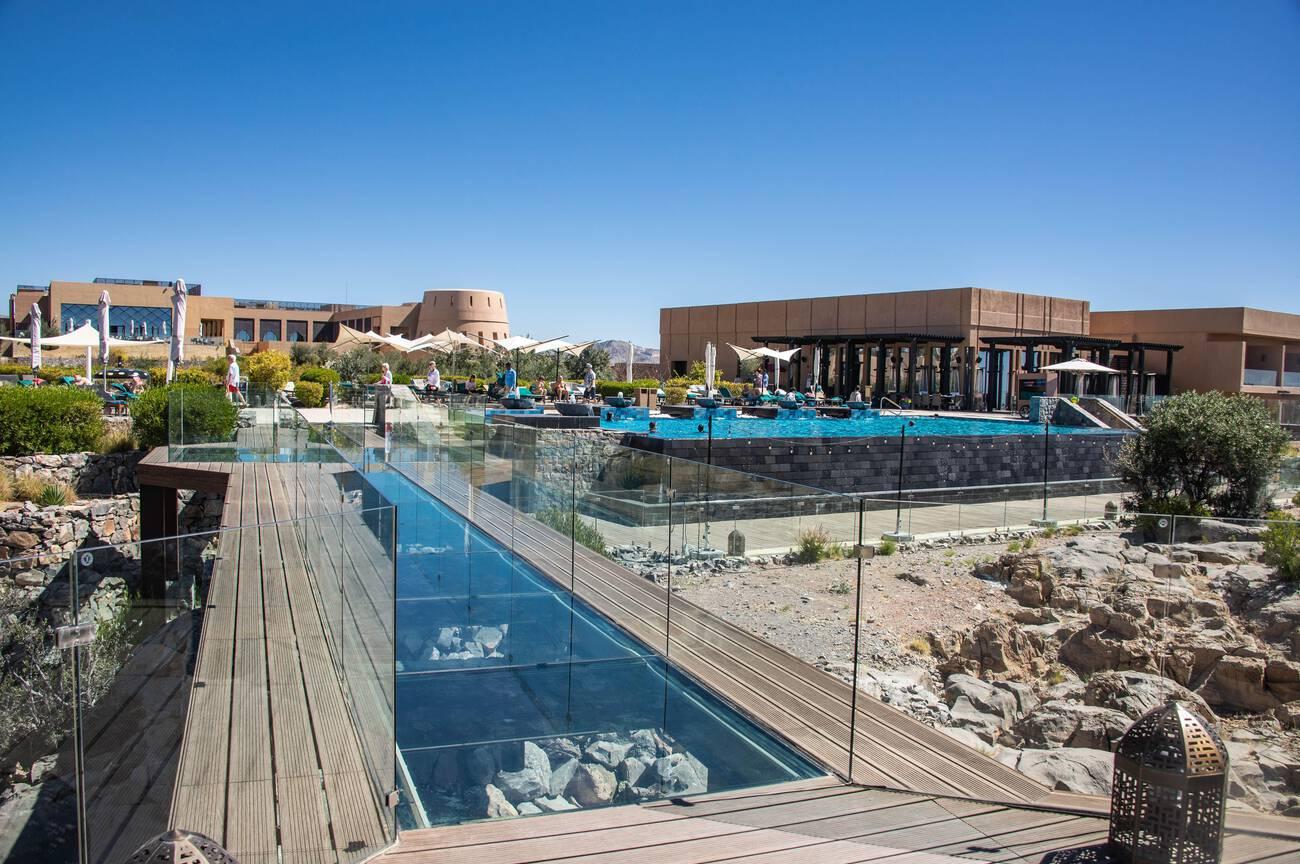
Boutique Stays
For a more personalized and personalized experience, Boutique hotels in Nizwa offer a charming atmosphere with unique touches:
- Nizwa Heritage Inn: This boutique hotel sits in the heart of Nizwa City. It provides an authentic Omani experience with traditional decor and personalized service.
- Al Misfah Hospitality Inn: Situated in the nearby Al Hamra region, this boutique property allows visitors to stay in a restored Omani house surrounded by stunning landscapes and traditional architecture.
Traditional Omani Guesthouses
If you want to experience local culture more closely, traditional Omani guesthouses are a great choice. These accommodations offer a more authentic feel while providing comfort:
- Bait Al Safah Guesthouse: Located in a traditional Omani house in Al Hamra, this guesthouse offers visitors a unique opportunity to experience Omani hospitality and architecture up close.
- Falaj Daris Hotel: A mid-range option with a traditional touch, this hotel combines modern amenities with a cultural atmosphere, providing a comfortable stay in Nizwa City.
Cultural Etiquette in Nizwa City: Respecting Local Traditions
When visiting Nizwa City, it’s vital to honor local customs and traditions. Oman is a profoundly cultural and conservative country, and understanding the cultural norms will ensure a respectful and pleasant stay.
Dress Code
- Modest Clothing: Visitors to Nizwa City should dress conservatively, especially in public places or when visiting religious sites. Both men and women should cover their shoulders and knees. Women may also choose to wear a headscarf when visiting mosques.
- Appropriate Attire for Religious Sites: When visiting a mosque or religious site, dress appropriately. Women should wear long pants to cover their hair, arms, and legs.
Behavior in Public
- Greeting Locals: It is customary to greet locals with a warm “Salaam” (peace), especially in the more traditional areas of Nizwa City. Handshakes are common among men, but avoid shaking hands with members of the opposite gender unless they offer first.
- Respecting Prayer Times: Omanis take their prayer times seriously. If you are near a mosque during the call to prayer, avoid loud conversations or disruptive behavior out of respect for the worshippers.
- Public Displays of Affection: Oman is a conservative country, so public displays of affection are generally frowned upon. It’s best to avoid hand-holding or hugging in public places.
Photography Etiquette
Ask for Permission: While Nizwa City offers many photo-worthy spots, asking for permission before photographing locals, especially women, is essential. Always be respectful and avoid taking pictures in sensitive areas like military zones or during religious ceremonies.
